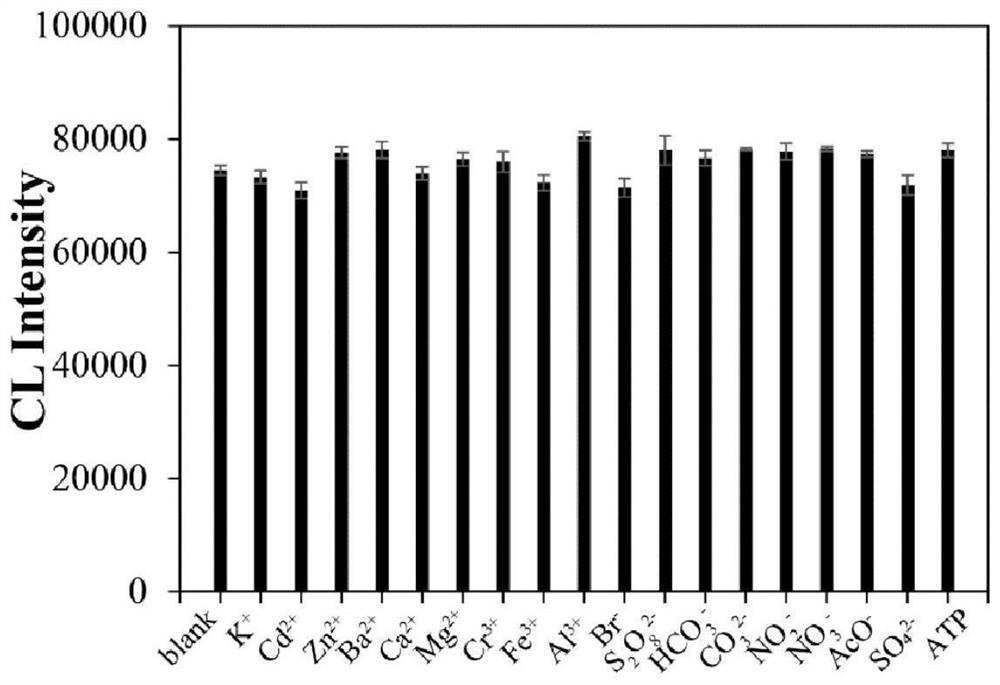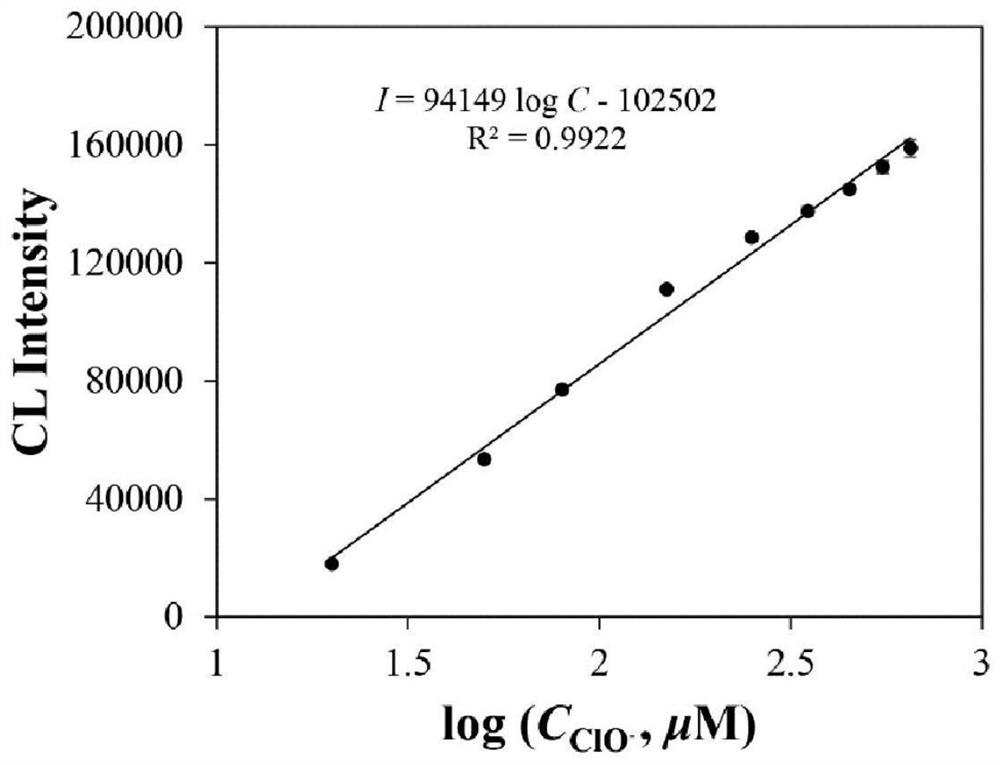Method for chemiluminiscence detection of hypochlorite
A chemiluminescence detection and hypochlorite technology, which is applied in the field of analytical chemistry detection, can solve the problems of complex molecular design and high synthesis cost, and achieve high sensitivity and selectivity, convenient operation, and rapid qualitative and quantitative detection.
- Summary
- Abstract
- Description
- Claims
- Application Information
AI Technical Summary
Problems solved by technology
Method used
Image
Examples
Embodiment 1
[0025] A 50 mM PBS (pH=7.4) buffer solution was prepared and used to dissolve the fluorescent gold nanocluster powder synthesized with glutathione as a ligand to obtain a 1.0 mg / mL probe stock solution. 200 μL of the probe stock solution was added to the quartz reaction cell, and placed in the sample chamber of the chemiluminescence analyzer, and a microsyringe was used to draw 200 μL of the active oxygen solution. The active oxygen species in the active oxygen solution were hydrogen peroxide, Hypochlorite ion, singlet oxygen, hydroxyl radical, superoxide anion, tert-butanol peroxide, tert-butanol peroxide radical, alkane peroxyl radical and peroxynitrite, the concentration of each active oxygen species is 200 μM was injected into the quartz reaction cell through the injection port, and the corresponding chemiluminescence intensity was measured on the chemiluminescence analyzer. Chemiluminescent test PMT working voltage is -1100V; time interval is 0.1s. Draw the chemiluminesc...
Embodiment 2
[0027] A 50 mM PBS (pH=7.4) buffer solution was prepared and used to dissolve the fluorescent gold nanocluster powder synthesized with glutathione as a ligand to obtain a 1.0 mg / mL probe stock solution. Mix 200 μL of the probe stock solution and 20 μL of other analyte solutions (other analytes are: potassium ions, cadmium ions, zinc ions, barium ions, calcium ions, magnesium ions, chromium ions, iron ions, aluminum ions, bromide ions, Peroxodisulfate ion, bicarbonate ion, carbonate ion, nitrite ion, nitrate ion, acetate ion, sulfate ion, adenosine triphosphate, and other analytes at a final concentration of 100 μM) added to quartz Reaction cell, and placed in the sample compartment of the chemiluminescence analyzer. Use a microsyringe to draw 200 μL of hypochlorite solution with a concentration of 200 μM, inject it into the quartz reaction cell through the injection port, and measure the corresponding chemiluminescence intensity on a chemiluminescence analyzer. Chemiluminesce...
Embodiment 3
[0029] A 50 mM PBS (pH=7.4) buffer solution was prepared and used to dissolve the fluorescent gold nanocluster powder synthesized with glutathione as a ligand to obtain a 1.0 mg / mL probe stock solution. Add 200 μL of the probe stock solution into the quartz reaction cell, and place it in the sample chamber of the chemiluminescence analyzer, draw 200 μL of hypochlorite solutions of different concentrations (20, 50, 80, 150, 250, 350, 450, 550, 650 μM) with a micro-syringe, and inject them respectively through the injection port into the quartz reaction cell, and measure the corresponding chemiluminescence intensity on the chemiluminescence analyzer at the same time. Chemiluminescent test PMT working voltage is -1100V; time interval is 0.1s. Get log value (log C) with concentration as abscissa, take chemiluminescent intensity (I) as ordinate plotting figure, obtain the working curve of hypochlorite concentration; Linear regression equation is: I=94149log C-102502 (the unit of C ...
PUM
 Login to View More
Login to View More Abstract
Description
Claims
Application Information
 Login to View More
Login to View More - R&D
- Intellectual Property
- Life Sciences
- Materials
- Tech Scout
- Unparalleled Data Quality
- Higher Quality Content
- 60% Fewer Hallucinations
Browse by: Latest US Patents, China's latest patents, Technical Efficacy Thesaurus, Application Domain, Technology Topic, Popular Technical Reports.
© 2025 PatSnap. All rights reserved.Legal|Privacy policy|Modern Slavery Act Transparency Statement|Sitemap|About US| Contact US: help@patsnap.com



